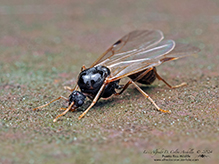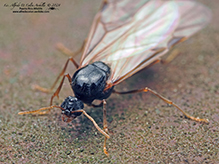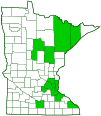smaller carpenter ant
(Camponotus nearcticus)
Conservation • Description • Habitat • Ecology • Distribution • Taxonomy
|
|
||||||||||||||
Description |
Smaller carpenter ant, also known as Nearctic carpenter ant, is a prevalent species of small ant. It is found in the United States and southern Canada, predominantly east of the Great Plains, with scattered and discontinuous populations present throughout the western regions. This species is among the most common and widespread within the subgenus Myrmentoma. Its habitats include prairies, woodlands, floodplain forests, other forested areas, and parks. Smaller carpenter ants form small colonies with a single nest, a single queen, and fewer than 500 workers. Typical nests have 200 or fewer workers. Nests are built in dead twigs and branches of trees; under the bark of logs, stumps, and living trees; in insect galls, hollow plant stems, and pinecones; and in wooden posts. The ants sometimes build nests in attics and in or under wooden roofs. They rarely cause structural damage, but they are considered a pest species in the east. Workers are ⅛″ to 5⁄16″ (3.5 to 7.5 mm) in length. The body is shiny, and it is sparsely covered with scattered, closely appressed hairs. There are two color forms. Some individuals are uniformly dark brown to black. On some individuals the thorax and the legs are partly or entirely orange or red. There are three different sizes of workers: minors, medias, and majors. Minors are small, majors are large, and medias are in between. On the majors, the head is about as wide as long and is squared off at the top corners. There are two large compound eyes and no simple eyes (ocelli). The antennae have 12 segments. The first segment (scape) is long, but it does not reach the rear lateral corner of the head. It has no erect hairs except at the very tip. The lower margin of the plate on the face above the upper lip (clypeus) is notched. There are very few erect hairs on the surface of the clypeus. There are sparse appressed hairs on the head, but there are no erect hairs on the cheeks. The entire front part of the body (mesosoma), when viewed from the side, forms a continuous curve. The abdomen consists of a large first segment (propodeum) that is fused to the thorax; a narrow waist-like second segment (petiole); and the bulbous remainder (gaster). The propodeum has a front upper face and a rear sloping face, and it is weakly angled between the two. The petiole has a single segment. The gaster is shiny. The legs are hairless or almost hairless. |
Size |
Worker total length: ⅛″ to 5⁄16″ (3.5 to 7.5 mm) |
Similar Species |
Habitat |
Prairies, woodlands, floodplain and other forests, and parks |
Ecology |
Season |
|
Behavior |
|
Life Cycle |
|
Larva Food |
|
Adult Food |
|
Distribution |
||
|
Sources |
|
| 2/13/2025 | ||
Occurrence |
||
Common |
||
Taxonomy |
|
Order |
Hymenoptera (Ants, Bees, Wasps, and Sawflies) |
Suborder |
Apocrita (Narrow-waisted Wasps, Ants, and Bees) |
Infraorder |
Aculeata (Ants, Bees, and Stinging Wasps) |
Superfamily |
Formicoidea |
Family |
Formicidae (ants) |
Subfamily |
Formicinae |
Tribe |
Camponotini |
Genus |
Camponotus (carpenter ants) |
Subgenus |
Myrmentoma |
Subordinate Taxa |
|
|
|
Synonyms |
|
Camponotus caryae pardus Camponotus caryae tanquaryi Camponotus fallax pardus Camponotus fallax tanquaryi Camponotus marginatus minutus Camponotus marginatus nearcticus |
|
Common Names |
|
nearctic carpenter ant smaller carpenter ant |
|
Glossary
Clypeus
On insects, a hardened plate on the face above the upper lip (labrum).
Gaster
The bulbous part of the abdomen of ants, bees, and wasps. In ants it usually begins at segment three.
Mesosoma
In Hymenoptera: the front part of the body, consisting of all three segments of the thorax and the first segment of the abdomen, to which the wings are attached.
Ocellus
Simple eye; an eye with a single lens. Plural: ocelli.
Petiole
On plants: The stalk of a leaf blade or a compound leaf that attaches it to the stem. On ants and wasps: The constricted first one or two segments of the rear part of the body.
Propodeum
In Hymenoptera: the last segment of the thorax, anatomically the first segment of the abdomen.
Scape
In plants: An erect, leafless stalk growing from the rootstock and supporting a flower or a flower cluster. In insects: The basal segment of the antenna.
Visitor Photos |
||
Share your photo of this insect. |
||
This button not working for you? |
||
Alfredo Colon |
||
 |
 |
|
MinnesotaSeasons.com Photos |
||
|
||
|
||

Slideshows |
|

Visitor Videos |
||
Share your video of this insect. |
||
This button not working for you? |
||
|
Other Videos |
||
|

|
Created: 2/13/2025 Last Updated: © MinnesotaSeasons.com. All rights reserved. |


